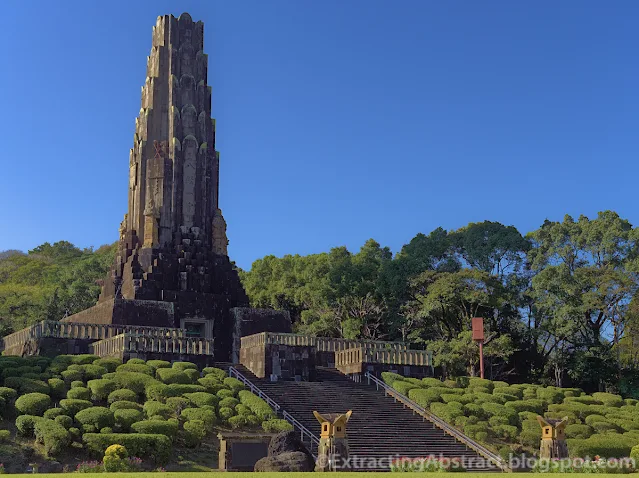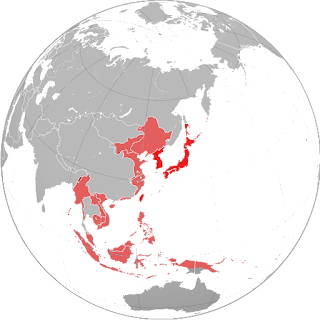Behind the story of the controversial tower goes on...
In 1935, Okada Cabinet (岡田啓介) launched the Committee for the 2600th Imperial Era Anniversary (紀元二千六百年記念行事). The original idea was to reform and expand the Kashihara Jingu (橿原神宮) in which Emperor Jimmu and his wife (Empress), Himetataraisuzu hime (媛蹈鞴五十鈴媛) are enshrined and the tomb of Emperor Jimmu and organize ceremonies in 1940. After the series of changes in the name and constitution of the Committee, the original plan kept swelling to the point of founding brand new shrines overseas such as Nanyoh shrine (南洋神社) in Palau and Kenkoku shrine/mausoleum (建国神廟) in the State of Manchuria. In addition, due to the enthusiastic promotion of the then Miyazaki Governer, Katsuroku Aikawa (相川勝六), the plan to build the monumental tower in Miyazaki was integrated into the initial plan, as well. You may wonder why in Miyazaki?

The so-called Heiwadai highland was opted for the place to build the memorial tower because the Heiwadai is closely located north of the palace (called Kohguh-ya/皇宮屋) where Emperor Jimmu settled until his Eastern Expedition. After all, the start and the end of Jimmu's Eastern Expedition were refurnished by subsidies.
Jitsuzo Hinago (日名子実三), a sculptor famous for designing Yatagarasu, a mythical three-legged crow for the symbol of the Japan Football Association (JFA), designed the Ametsuchi no motohashira tower free of charge. When designing the tower, Hinago was inspired by Gohei (御幣) he saw in Miyazaki Jingu (宮崎神宮). Gohei is one of the offerings to the enshrined deities (Shinsen/神饌). Being Shinto as part of animism, ancient Japanese acknowledged mother nature (divine beings) that made their living on hunter-gathering. Harvested cereals, fruits, vegetables, sake (Japanese wine), and textiles, are offerings in many cases whereas Gohei is a non-edible offering. In many cases, Gohei is made up of wooden wands decorated with two shide (zigzagging paper streamers). Apart from offering purposes, Gohei was considered as "Yorishiro (依り代)", an object that the deity haunts. At each corner of the tower, statues of four deities made of stoneware in Shigaraki style (信楽焼) are deposited. They are called Aramitama/荒御魂 as a worrier, Nigimitama/和御魂 as a merchant, Sachimitama/幸御魂 as a farmer, and Kushimitama/奇御魂 as a fisherman, respectively.
 |
| Aramitama/荒御魂 as a worrier |
 |
| Nigimitama/和御魂 as a merchant |
 |
| Sachimitama/幸御魂 as a farmer |
 |
| Kushimitama/奇御魂 as a fisherman |
Governor
Aikawa actively contacted newspapers for promoting the concept of a new tower. Aikawa’s ideas of building a new tower were (1) to symbolize
Emperor Jimmu’s aspiration of establishing a new country and the prosperity of Imperial Japan in the future and (2) to record the accomplishments of Japan 2600 years after his
Eastern Expedition. To come Aikawa's ambitions and concepts to fruition, especially for the purpose of objective (2), founding stones for the tower base were dispatched not only from domestic Japanese territories but also overseas such as
Manchuria, South Pacific islands, and European and American continents. Altogether, 1789 stones (most of which were from Miyazaki Prefecture and closer prefectures) were piled-up for building the base of the tower. Of 1789 stones, 349 stones were delivered from overseas.
3 from Canada
2 from the US
1 from Peru
1 from Nazis Germany
4 from Southeast Asia and Pacific Oceania
118 from Korea Peninsula
104 from China (58 of which were plundered by expeditionary forces from the hostile ground)
80 from
Manchuria (6 of which were looted by expeditionary forces from the hostile ground)
36 from Taiwan
 |
The largest territory of Imperial Japan (Image from Wiki with modification)
|
Among stones "
donated" from
Manchuria, China, and Korea, some were the plunders from historical buildings/monuments by Imperial Japan military forces. Obviously, the intention of the Government was to proudly declare the augmentation of the country that launched from the Kashihara district 2600 years ago and expect further prosperity in the following century, 2700. In fact, the numbers of population, territory size, and how far the reign of the Emperor has augmented overseas were inscribed on the back side of the tower. Stones dispatched from overseas were the smoking gun evidence to prove it. Now we all know that the everlasting expansion policy of Imperial Japan evaporated into a mirage after WWII yet in 1940, the Japanese, especially politicians, were obsessed with mythical and patriotic fairytales.
Due to the occupation by the
Allies of WW II, Japanese mass media and politicians made a swift “
left” turn. Commanded by
Supreme Commander for the Allied Powers (SCAP) in 1946, the worrier statue, “Aramitama”, and the letter “八紘一宇” inscribed on the front were expropriated! The name of the tower changed to
"Peace Tower" (平和の塔)" in 1957. The name of the tower remained the same by now. The worrier statue and the inscribed letter were restored in 1962 or 1965, respectively. Till the tower was restored to its original design, the tower has been ruined. It was used for practicing rock climbing. Affirmative, the tower is made of rocks...
 |
| Rock climbing the tower (Image from Wiki) |
What a terrible change the tower has been through!!!
.










No comments:
Post a Comment
Your comments are always welcome! It's NOT a bad idea to follow this blog, if you are not a follower already:)
日本語でのコメント大歓迎です。